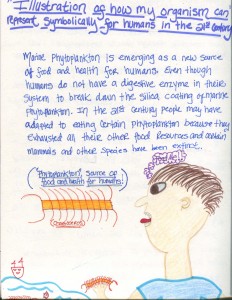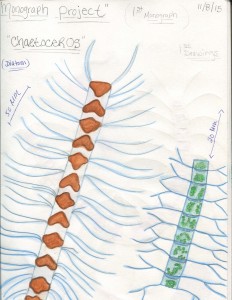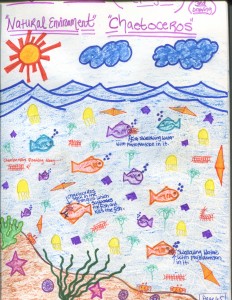Chaetocerotaceae, Chaetoceros:
By: Sarah Scott
Introduction:
Chaetoceros is the largest genus of marine plank-tonic diatoms. Their cells form chains that are coiled, curved, or straight. Long setae emerge from corners of the cells. It is one of the largest genera of diatoms, roughly 400 species, most of which are marine and there were a few solitary species that were found in Monterey Bay. Chaetoceros species have a worldwide distribution, and they often dominate marine ecosystems. Some have caused important blooms in both oceanic and coastal habitats and some species form resting spores and/or aux-spore. It is often very difficult to distinguish between different Chaetoceros species and several attempts have been made to restructure this large genus into subgenera but the work is still in progress. The genus Chaetoceros were first detected by Ehrenberg in 1844 from Antarctic Ocean specimen and the cells are more or less rectangular in girdle view and are usually elliptical in valve view. Opposite setae of adjacent cells touch near their origin and the cells are united into chains, they have very characteristic spores and the base of setae is short. The seta structure is an extended empty processes that begin on the valve surface corners. These setae generally comprise terminal and intercalary setae, the former at the end of a chain and the latter within the chain. Sometimes, a few species have unusual intercalary setae, called special intercalary setae, these are thicker and much more strongly silicified than the common intercalary setae. Diameter is 10-50 μm, the length is 6 – 30 μm and the shape is elliptic cylinder.
Chaetoceros is a centric diatom with very lightly silicified frustules. Each frustule possesses four long, thin spines, or setae. The setae link the frustules together to form colonies of several cells. Frustules are usually seen in girdle view. Chaetoceros is primarily a marine genus, with only a few representatives in inland waters of the United States. Inland cells reach their greatest abundances in saline or brine contaminated rivers and lakes. Chaetoceros produces heavily silicified resting cells that are often preserved in sediments. Because of high growth rates and contain high concentrations of lipids,Chaetoceros has been used as a potential alga to harvest lipids for bio-fuels (Spaulding, S., and Edlund, M., 2008).
In mid-March when the water column is stratified and a thermocline is present, diatoms are generally the more dominant phytoplankton. Chaetoeros debills have tiny bristles that extend from the cell of the body which slow down their sinking. This Chaetoceros is the distinctive phytoplankton of the Gulf of Maine. From corners of each cell, long thin setae or bristles extend outward then fuse with the neighboring cell and this arrangement can create a long spiral, up to 2 mm long. Even though it may seem this organism is long, each cell is actually distinct and separate from the neighboring cell. By joining together they increase their surface area. Joining into this long chain ensures that the cells will remain at the surface for a longer period of time, having more of an opportunity to capture energy from the sun.
Physical properties of phytoplankton such as Chaetoceros can physically damage marine organisms. The siliceous spines from the genus Chaetoceros, can stick into the gill filaments of a fish causing irritation. Mucous is then created by fish to coat the gills in order to relieve the irritation. In promoting greater mucous production, the gills are no longer efficient enough to extract oxygen from the water, thereby causing the fish to die from suffocation. Though this type of bloom is rare, there was an incident in Dabob Bay, Washington in October of 1991 where cell abundance did reach up to 103 cells per liter (Runyan, 2014).
Morphology:
of the species Chaetoceros is characterized by the presence of two 90° rotations of the resting spore during maturation. First a rotation in the apical plane of the mother cell resulting in the valvar plane of the resting spore turning from parallel to perpendicular to that of the mother cell, and a second 90° rotation in the valvar plane of the mother cell resulting in the valve faces of the resting spore turning from facing narrow girdle view to broad girdle view of the mother cell. It is the first report of two 90° rotations of resting spores during maturation in Chaetoceros. (Yang Li, Suying Zhu, Nina Lundholm, Songhui Lu, 2015). The general morphology of Chaetoceros tenuissimus is very similar to that of most members of the subgenus Hyalochaete. This subgenus was defined by Gran (1897) and revised more recently by Evensen & Hasle (1975). It includes delicate forms either chains or solitary cells with thin appendages and chloroplasts only in the body of the cell (not in the setae). The prevalence of intact diatom resting spores such as the genus Chaetoceros, in newly up-welled waters demonstrates the ability of spores to utilize the mixing and current patterns in order to seed up-welling systems. Higher sinking rates would appear to be the key advantage to spore formation, rapidly removing the population from an inhospitable environment following nutrient depletion, thus preventing offshore advection and maintaining the population close to the center of up-welling.
Morphology is Centric:
-
Cells lack a raphe system and lack significant motility
-
Cells may possess fultoportulae (strutted processes) and rimoportulae (labiate processes)
-
Sexual reproduction is oogamous
I think my organism can represent symbolically for humans in the 21st century by being a food source. Marine phytoplankton is emerging as a new source of food and health for humans. Even though humans don’t have a digestive enzyme in their system to break down the silica coating of marine phytoplankton. In the 21st century people may have adapted to certain phytoplankton because they have exhausted all their other food resources and certain mammals and other species have gone extinct.

Scientific Classification:
Domain: Eukaryota
Kingdom: Chromalveolata
Phylum: Heterokontophyta
Class: Bacillariophyceae
Suborder: Biddulphiineae
Family: Cheatocerotaceae
Genus: Chaetoceros
Animation of my organism Chaetoceros.
Bibliography:
1.) Seasonal Variation of the Genus Dinophysis within Puget Sound, Washington: Understanding Harmful Algal Blooms through Species Identification. By Jennifer Sun Runyan, 2014.
2.) Coordinating Uses of Land and Water, prepared by the Aquaculture Group Environments: Chemistry, Ecology, and Politics, The Evergreen State College, Olympia, WA, June 1977.
3.) Morphology and taxonomy of the planktonic diatom Chaetoceros species (Bacillariophyceae) with special intercalary setae in Korean coastal waters. By Sang Deuk Lee, D. Jin Hwan Lee, May 2, 2011.
4.) Morphology and molecular phylogeny ofChaetoceros dayaensis nov. (Bacillariophyceae), characterized by two 90° rotations of the resting spore during maturation. By Yang Li, Suying Zhu, Nina Lundholm, Songhui Lu, April 2, 2015.
5.) The Morphological Study of Cheatoceros Tenuissimus Meunier, a Little Known Planktonic Diatom, With a Discussion of the section simplicial Subgenus Hyalochaete. By Eugenia A. Sar, David U. Hernández-Becerril, Inés Sunesen. Diatom Research (2002), Volume 17 (2), 327–335, November 2002.
6.) Phytoplankton seed populations of the Cape Peninsula upwelling plume, with particular reference to resting spores ofChaetoceros(bacillariophyceae) and their role in seeding upwelling waters. By C. Pitcher, Volume 31, Issue 3, September 1990, Pages 283–301.
7.) http://oceandatacenter.ucsc.edu/PhytoGallery/Diatoms/Chaetoceros.html
8.) http://www.eos.ubc.ca/research/phytoplankton/diatoms/centric/chaetoceros/chaetoceros_genus.html
9.) http://www.eos.ubc.ca/research/phytoplankton
10.) Encyclopedia of Life (EOL). 2012.Chaetoceros. http://eol.org/pages/12010/overview. Accessed 18 Mar 2012
11.) Guiry, M. D. 2012. Chaetoceros Ehrenberg, 1844. Accessed March 18, 2012 http://www.marinespecies.org/aphia.php?p=taxdetails&id=148985
12.) Guiry, M. D. and Guiry, G. M. 2012.Chaetoceros Ehrenberg, 1844: 198. Accessed March 18, 2012. http://www.algaebase.org/search/genus/detail/?genus_id=43689
13.) Spaulding, S., and Edlund, M. (2008). Chaetoceros. In Diatoms of the United States. Retrieved December 03, 2015, from http://westerndiatoms.colorado.edu/taxa/genus/Chaetoceros









